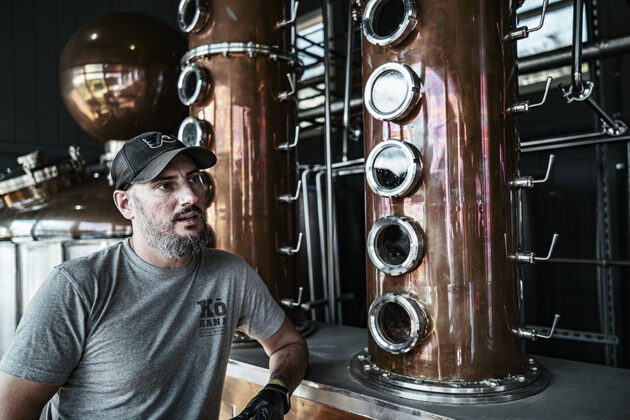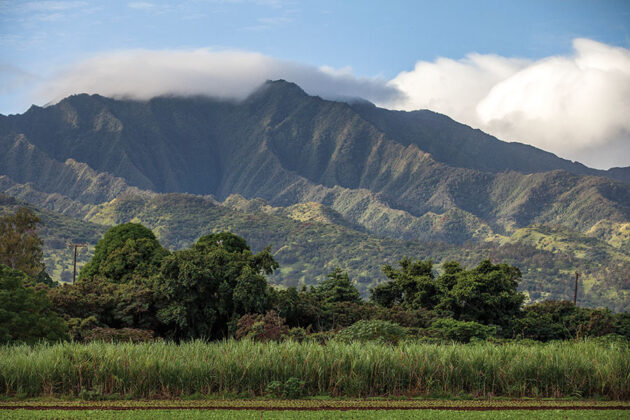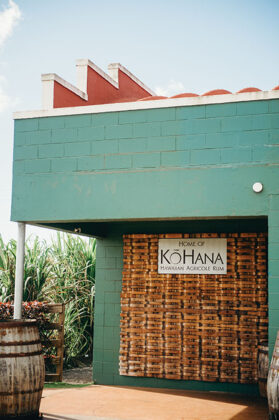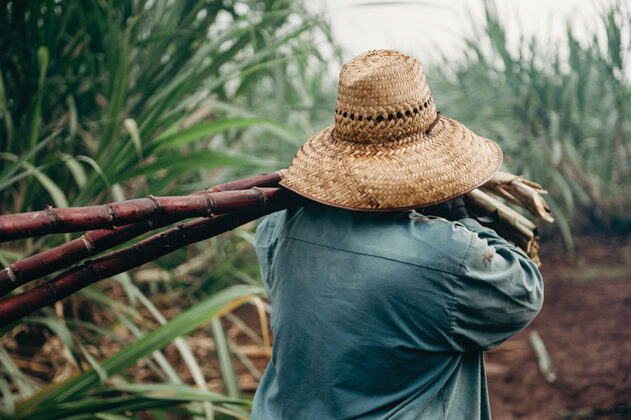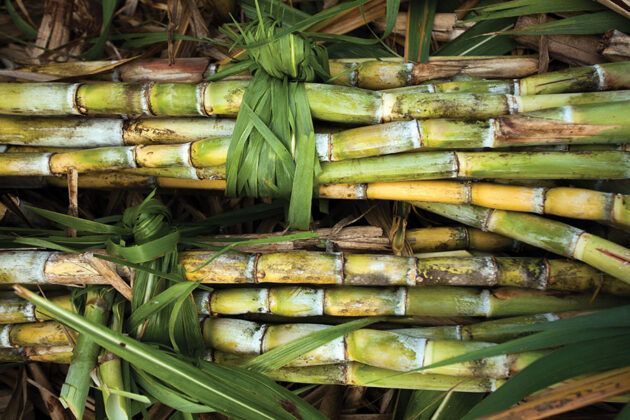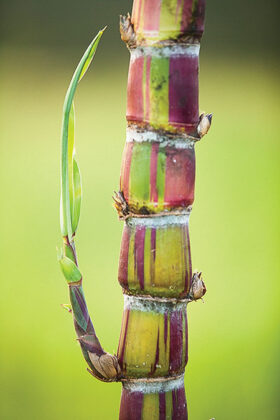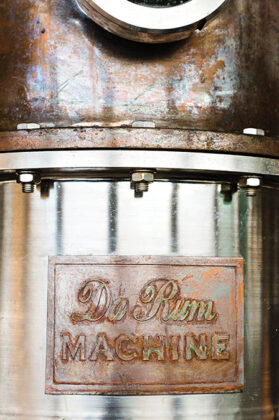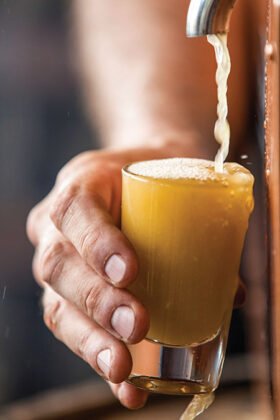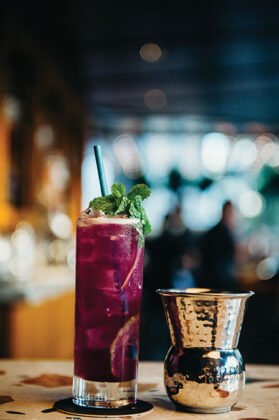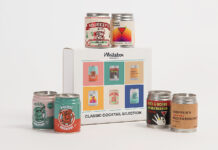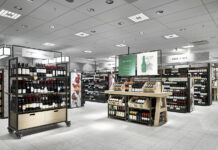Kō Hana Distillers is a pioneering Hawaiian distillery specializing in agricole-style rums. The company began in 2009 as a farm, launching its first agricole-style rum made entirely from Hawaiian-grown sugarcane in 2014. Founders Robert Dawson and Jason Brand have revived and rebirthed Hawaii’s rich history of sugarcane by growing varying types, then using them to make variety-specific agricole-style rums, each with nuanced flavors and expressions, not unlike different agaves in mezcal or grape varieties in pisco.
For the past decade-plus, Kō Hana’s team has hand-harvested all cane. But as demand increases for their incomparable Hawaiian rums, Kō Hana is scaling up, even as they remain “small batch.” In April 2022, I visited one of their sugarcane plantations on Oahu on the first day they were using their new John Deere harvester. The smell of fresh-cut cane in the fields, surrounded by mountains with the ocean nearby, is magic.
The varying tastes and colors of Hawaiian sugarcane is a fascinating realm revealed by Brand, Dawson, and brand manager Kyle Reutner, who came on board soon after they launched their rum. A partnership with Noa Kekuewa Lincoln, assistant professor at University of Hawaii at Mānoa, has also been key to reviving ancient Hawaiian sugarcane varieties.
In his own words, Dawson tells us about Kō Hana’s journey to distilling and what is unique about Hawaiian kō (sugarcane) and the Hawaiian agricole they create.
What brought you to Hawaii?
In 2008 my business partner, Jason Brand, and I both independently moved to Hawaii from elsewhere. We were both drawn to the islands because of the strong sense of community and love of family. We ended up meeting the day our two children began kindergarten together. My wife and I really wanted to raise our child in Hawaii, and that precipitated our journey that ultimately led to distilling. We called it our 13-year plan to raise our son with aloha and get him off to college.
My upbringing’s cornerstone value was that, “to whom much is given, much is required” [Luke 12:48]. I felt incredibly blessed to be able to move my family to perhaps the most beautiful place in the world, and once here, I really began to look for something I could do that would not only allow me to make a living but also give back to the community that welcomed me. Oddly enough, Jason and I independently became interested in agriculture. Jason was interested in food security, and I was looking to develop a high value product ultimately suitable for export. Before we became formal business partners, we both first became farmers.
What personally led you into distilling?
My journey to distillation started with a deep dive into Hawaiian agriculture. I was fascinated by the many industries that once thrived here but were now in decline. I hoped to find an opportunity others had missed. That led me to meet with the Hawaii Agricultural Research Center (HARC). They are the preeminent plant researchers in Hawaii, and I approached them looking for advice on opportunities in agriculture. They pointed me toward biofuels and provided me with research materials and direction. At the time, this seemed like a great fit for what I wanted to do, albeit outside my original plan. While Jason was looking into food security, I was diving into energy security. But the path quickly shifted with the rediscovery of “native Hawaiian sugarcane,” called kō in the Hawaiian language.
Reading through the literature provided to me, I began to learn about the dominance of sugarcane in the Hawaiian Islands starting in the early 1800s, but my research also mentioned that sugarcane was originally a canoe plant brought by the Polynesian seafarers to Hawaii 1,000 years ago on a 3,000-mile open ocean journey. As a history buff, I wanted to know more about this, so I dove in and was hooked. The early Hawaiian people brought dozens of different varieties of sugarcane to the islands. Each had unique characteristics with medicinal and spiritual significance to the original people here. What the early botanists also said was that the varied sugarcanes had unique sugar content properties and unique flavors. I immediately lost interest in biofuel and decided to find a way to tell the story of kō.
I had spent a fair amount of time in Brazil previously and had always been a fan of cachaça, the Brazilian rum made from sugarcane juice, and I thought this was the direction I would take. I wanted to experiment with as many different types of kō as I could find and create a world-class rum made from these incredible plants. Unfortunately, I quickly found out that no one grew these plants commercially. The big sugar mills brought in or created hybrids for their operations. They had no interest in these beautiful plants, so they disappeared into backyards and botanical gardens. Starting this farm would mean starting from scratch.
Working with the scientists at HARC, I was pointed to various places I might find these canoe plants. Waimea Botanical Gardens was one of my first stops, and that’s how I came to know Noa Lincoln, the preeminent ethnologist studying Hawaiian plants. Noa was working on his PhD at the time. The head of the Waimea Gardens told me I should reach out to Noa as we both seemed to have a true passion for kō. We became friends, and I worked with him whenever I could to find and classify all the different varieties of kō still in Hawaii. Noa literally wrote the book on kō during these years. [Kō: An Ethnobotanical Guide to Hawaiian Sugarcane Cultivars, University of Hawaii Press, 2020] After about a year of work, we had found and identified 34 varieties, and I had started a farm. A year later, I was tasting the juice from these amazing plants and learning everything I could about them and their cultural significance. Soon after, Jason and I founded our distillery and began building Kō Hana together.
Tell us what is unique about your distilling and production process.
We are the only rum distillery in Hawaii that is 100% farm-to-bottle. We do not use any molasses or refined sugar, nor do we blend our rum with other rums. What is truly unique about us is that our process is done from a single varietal perspective. Each variety of sugarcane we grow is unique in flavor, so we highlight this. We harvest one variety at a time. We then ferment, distill, rest, and barrel age as single varietals. Each bottle states the name of the sugarcane from which the rum was created. This is a long process compared to other rum distilleries.
We ultimately follow the French agricole style with a Hawaiian twist. Agricole white rum is rested for three months in stainless steel tanks before being bottled. From the time we plant the sugarcane, it is 12 months before we can harvest. Then, it is a week of fermentation and distillation. Finally, we rest the rum for three additional months. That means the shortest time for us to make a single bottle of rum is 15 months. This is by far the hardest way to make rum, but our ethos is “no shortcuts,” and we believe it shows in the products. We are a true business of Hawaii, and we couldn’t be prouder of the team we have and what we have accomplished. They say imitation is the sincerest form of flattery, and we see other distilleries now following our model in some way in what they do. This is great for Hawaii.
How is your business affected by — and surviving — the pandemic?
Our “no shortcuts” ethos made the pandemic especially hard for us. As the only rum distillery in Hawaii fully reliant on its own farms, we couldn’t just shut down and wait out the pandemic. When Hawaii shut down and isolated, the bars, restaurants, and tourists visiting our tasting room disappeared along with over 70% of our revenue. Plants don’t care about pandemics, so we had to maintain our farms while pivoting to become one the largest producers of hand sanitizer in Hawaii. We felt honored to be in a unique position to be able to provide much needed hand sanitizer at a time the state was in very short supply. This shift allowed us to weather the storm, maintain our farms, and come out stronger in the end.
How does your location influence what you create?
We are fully defined by Hawaii in everything we do. We are honored to be able to tell the story of the ancient sugarcane brought to the Hawaiian Islands 400 years before sugarcane arrived in the Caribbean. Kō, Hawaiian sugarcane, is sacred and special. Every part of what we do honors the opportunity Hawaii has given us. Being able to share the stories and traditions of Hawaii through our Hawaiian agricole rum is an incredible blessing that we never take for granted or disrespect.
What do you feel are the key elements of getting your brand out there?
We encourage familiarization tours with all our potential buyers. As a distillery with a “no shortcuts” ethos, we love to open our doors and show people what we do. Everything is out in the open and the passion we have for what we do is palpable. It is honestly easier to show than explain, so this is our best marketing tool.
How do you envision the world of small-batch spirits evolving?
Like all nascent industries, things will evolve in the coming years. Pioneers like St. George in Alameda started in the 1980s, but most of the rest of us have only been doing this for 15 years or less. This industry is very, very young. I think we will see great things. There will be some consolidation and some failures, but the overall effect will be the creation of great spirits made in new ways no one even considered before. This is an exciting time. Starting a distillery is not for the faint of heart, but it can be an incredible journey for anyone with the passion to do the work and chase a dream.

